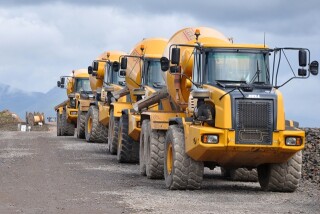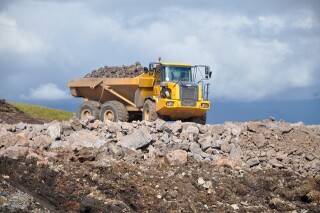With approximately 90 wind farms currently under construction in the UK, developers are taking full advantage of the UK’s enviable claim to fame as the windiest region in Europe. But although wind is free, much capital investment is needed at the outset. This, combined with often isolated locations, harsh terrain and other environmental constraints, can lead to quite challenging construction schedules.
At Carraig Gheal windfarm in Scotland, specialist earthmoving contractor CA Blackwell (Contracts) has nevertheless shown how careful planning and technical ingenuity can more than cope with these demands. Carraig Gheal is, by most people’s standards, remote. Only 30km from the west-coast resort town of Oban in the Argyll & Bute region of Scotland, it is nevertheless not an easy place to reach by road. Then there’s the site itself. Around 1,200 hectares in size and rising to 450m above sea level, the Carraig Gheal site was essentially a hilly Highland wilderness, with just the occasional narrow dirt track, furrowed over generations by local foresters and farmers. That was still the case in early spring 2012. Yet by summer Essex-based Blackwell had created more than 45km of robust roadway across the site. Almost 10km of this provides access to the 20 turbine sites, while the remainder has been constructed through the site to aid the local forestry industry and help remove traffic from the local lanes. On top of this, Blackwell constructed 76,850m2 of hardstanding area.

David McCracken, project manager for Blackwell on the Carraig Gheal site, says: “Whichever way you look at it, that’s pretty good going. We’ve turned that aspect of the job round very quickly, and that’s only a small part of what we’ve had to do.” Much of the urgency was the result of factors outside Blackwell’s control. The company was appointed as the main contractor by Green Power, a private enterprise firm, as recently as Christmas Eve 2011 after the original contractor pulled out, leaving Blackwell to step in at the eleventh hour and pick up the pieces. And by then the Scottish winter was making its presence felt. “We suffered a terrible winter initially,” says McCracken. “It was pretty disastrous in terms of getting work done. It’s already a rough environment, but when you add a lot of wind, rain and snow, and the fact that it gets dark very early, means the schedule was looking quite scary.”
Fortunes turned around though, and road construction began in February 2012 – and continued at a startling pace. It helped that the weather became relatively kind, but a technical innovation that saw standard Bell B30D articulated dump trucks (ADTs) double up as off-road concrete mixers was also key.

In addition to problems created by the terrain and the weather, the project has had to deal with numerous ecological constraints, some of which either increased the workload or delayed the schedule, or both. Blackwell has employed its own ecologist throughout the project to work with the client’s own ecological team and generate solutions to the wildlife protection issues. Nesting ospreys, golden eagles and redthroated divers have required consideration and protection – sometimes to a point where work has had to stop on parts of the site. When sections of road became impassable due to nesting birds, they had to go off-road. “This is why we were always going to use articulated dump trucks,” says Blackwell’s resource manager, Rob King. “There was never any other vehicle that was going to move the materials in the conditions we had. And the Bell trucks are extremely manoeuvrable.” It is for that reason, he says, that Blackwell decided to work with Bell to find a way of turning its classic ADT into an off-road concrete mixer.

The Bell ADT concrete mixers had been recently developed and trialled on the Clyde windfarm project and had proven successful. So Blackwell commissioned the conversion of five Bell trucks. Working in tandem with concrete mixer specialist Utranazz, a specially designed subframe was fabricated to allow Blackwell to mount a self-contained, self-powered mixer unit onto the dump truck chassis. “We tweaked a few elements here and there, like repositioning radiators, installing new dampers and improving some brackets. We wanted the mixer unit to be completely independent from the existing electronics within the truck, so that we could retain the flexibility to convert it back to a standard haul truck,” says King. Other operators had attempted similar conversions previously, but only in a “very crude roll-on, roll-off skip lorry” manner. This was the first time that a fully functioning concrete mixer had been created using an ADT chassis, which could also be easily converted back to a basic ADT within four hours. King says: “This flexibility not only means our trucks can be utilised even when batching and pouring isn’t taking place, but it also gives us flexibility with our drivers. This can be very useful at a remote site like Carraig Gheal, where labour is not always easy to source.”
Each of the 20 turbines at Carraig Gheal stands in a base of 330m3 of concrete and 45 tonnes of steel. Due to the sheer volume of concrete, Blackwell built its own batching plant on site. Without this facility, it would have been impossible to meet the schedule, not least because standard concrete mixers would not have been able to access the places that the ADTs could. “We’d have had to be much more critical with the roads if we’d attempted to use normal concrete mixers,” King says. “We simply wouldn’t have had the time for that on our already very tight work schedule. The Bells have no problem coping – and don’t create anywhere near the amount of downtime we might have faced with other methods of transport in these difficult ground conditions.”

When road building was at peak, Blackwell had around 30 Bell ADTs on site, hauling rock and peat on steep and difficult terrain, working alongside dozers and excavators. The 20 turbine sites are dotted across the central section of the site, 500m apart. Each turbine site is initially excavated and a platform of approximately 100mm of reinforced concrete is prepared to provide a flat working base. Each turbine base takes on average three weeks to construct. Within a few months of work, not only did the roads have to be completed, but the bases had to be ready in time for the delivery and installation of the first turbines in early September 2012. There was also more than 11km of cabling track to lay, to connect each turbine – typically along the route of the roads, but sometimes across country.
Siemens has been responsible for installation of its 2.3MW turbines – the logistics of which have left no room for unscheduled on-site delays. Blackwell’s initial handover date is 18 December 2012, meaning the installation schedule has run to about two turbines per week. The final handover is in March 2013, though the bulk of the work will have been completed this year. South African manufacturer Bell Equipment believes that Blackwell has hit upon a perfect solution for concrete handling in the windfarm industry – one that could have a significant impact on getting projects built on time and to budget. “It’s a truly innovative use of an ADT,” says Simon Bridge, regional sales manager for Bell Equipment UK.
Got a story? Email news@theconstructionindex.co.uk



